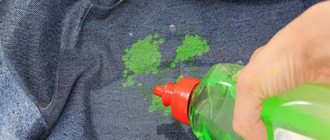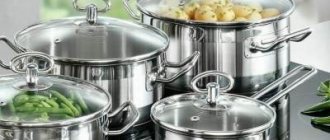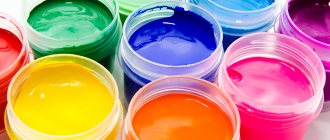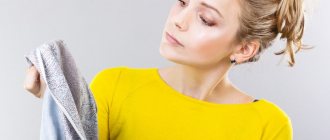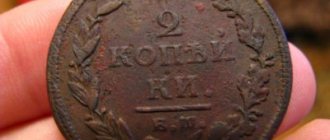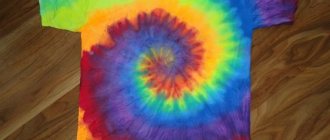The following situation is familiar to most people. You were painting something, you were hot, you were tired... Consequently, various small final tasks (including cleaning brushes) fade into the background, you forget about them. For the next painting, a hard brush with dried paint becomes completely unsuitable. Therefore, you have to either buy a new tool or try to clean it. The choice of solution mainly depends on the price - there is no point in washing cheap brushes, but it is worth trying to clean more expensive ones. Let's find out different ways to clean a brush from paint, returning it to its usability.
Why wash your brushes right away?
Experienced artists know to clean their tools immediately after work. It doesn’t matter how tired you are or how much there is to wash, clean and put away – that’s it.
But newcomers to the world of painting very often neglect this rule, which is why they suffer later. But in vain! After all, cleaning acrylic brushes is as easy as shelling pears, because this paint easily dissolves in water!
Therefore, the first thing you should remember when using acrylic and other paints is to wash your brushes immediately after use!
Special brush washer
This is a container in the form of a small saucepan with a spring soldered to it on top. Thinner is poured inside, and the brush is fixed in the spring so that its bristles are completely immersed in the product. After cleaning, you can store the brush in the brush tray, but then you add oil instead of solvent. Sunflower or flaxseed will do.
To keep the bristles of the brush soft, it is enough to immerse only the ends of the bristles in the oil.
What to do if acrylic paint has already dried
Of course, it will not be as easy to wash dried acrylic paint brushes as with water immediately after use, but it is quite possible. To avoid damaging the brush, you do not need to scrape the paint dry. Then how can you clean a brush from dried acrylic paint? It is enough to use an acrylic paint solvent. Many brands have this, you can choose, for example, .
It’s better to wash your favorite brushes right away! Never forget about this and they will serve you for many years!
If you don't have this on hand, try good old white spirit, pinene or turpentine. They will definitely remove all the paint from the brush! But remember that you need to work with solvents carefully - do not allow the solution to get into the place where the fibers connect to the fastener. Otherwise, the solvent will corrode the bonding glue, and your brush will lose precious fibers!
If you want to learn more about working with acrylic paints, I suggest you try your hand at my FREE master class, where you can paint your first acrylic painting! I PROMISE that in 1.5 hours at the master class we will paint a gorgeous interior painting! Even if you have never held a brush in your hands before! By the way, the new painting will fit perfectly into any interior!
Register using the link - https://nyschool.ru/mk_les?utm_source=seo&utm_medium=blog&utm_campaign=allseo
Cleaning methods
In the instructions for the paint and varnish material, manufacturers usually indicate how it can be removed after painting.
Oil paints can be easily wiped off with turpentine or kerosene, and water-based paints can be easily washed with water. Other paints can be washed off with thinner, solvent or cleaning compounds.
After using solvents, the cleaned brush must be rinsed with water and dishwashing detergent.
The method will depend on the type of paint.
Nitro paints
Synthetic-based nitro paints cannot be washed with water. Thinner will help remove it.
Nitrosolvents
A little diluent is added to the jar. The brush is immersed in the cleaning agent and dipped in it intensively so that the diluent gets into every fiber. The tool remains in the jar for at least 2 hours. After the time has elapsed, the brush is removed and thoroughly wiped. Now it can be stored in a dry place until next use.
Remaining thinner must not be poured into the washbasin. The jar with the solution is covered with a lid and left until the particles of washed-off paint settle to the bottom. This usually takes a day. The filtered solvent is poured back into the bottle and can be reused. When the remaining paint at the bottom of the can is completely dry, you can throw it in the trash.
Acetone
The painting tool is soaked in acetone. After washing, the brush is rinsed in a warm soap solution. If contamination still remains, the procedure can be repeated. Use acetone to rinse off the enamel well.
Oily
Excess paint is squeezed onto paper, dried pieces are separated with the blunt side of a knife. To finally get rid of the remaining oil paint, it is immersed in a container with thinner, then washed thoroughly.
Turpentine
The brush is soaked in turpentine and washed. Cleaning is completed by rinsing with soap and water.
RS-1
The solvent is added to a small container. The brush is immersed in it. Excess product is wiped off the instrument with paper or newspaper. Dry the brush in the open air.
White Spirit
Cleans off in the same way as acetone or turpentine. If the contamination cannot be removed the first time, the washing is repeated.
Kerosene
After soaking in kerosene, the brushes are washed in a warm soapy solution.
Alkaline solution
Used for dried paint. The instrument is soaked in the solution, and after a while it is washed and rinsed in soapy water.
Isopropyl alcohol
Effectively removes oil and acrylic paint. Alcohol is used similarly to acetone.
Vinegar
The brush is soaked in alcohol vinegar, then washed with soapy water. If the paint is poorly removed, cleaning is repeated.
Dish gel
Dishwashing detergent cannot remove the dye, but you can wash off any remaining solvent from the brush.
Afterwards, the instrument is thoroughly rinsed with running water.
Water-based
To remove the remaining water emulsion, the brush must be washed in warm water. To remove dried paint, the tool is immersed in water for 2 hours, then washed and dried with a dry cloth.
Acrylic
They are based on a plastic polymer, so, unlike oil-based ones, acrylic ones can be wiped off brushes without toxic thinners.
Warm water
Excess paint is squeezed onto the paper, the frozen pieces are scraped off the pile with the back of a knife blade. The brush is thoroughly washed under running heated water. Dried dye can be removed with warm water and a small amount of dishwashing detergent. After cleaning, the instrument is rinsed and dried.
Degreaser
Acrylic paints, like oil paints, can be cleaned with a degreaser. Isopropyl alcohol, vinegar, gasoline or dishwashing liquid are suitable. The products are used in the same way as when cleaning painting tools from oily material.
Special cleaners
The Pensselipes cleaner from Tikkurila is effective. It removes almost all known paints well. Does not contain solvents and smells pleasant. After using the cleaner, the tool retains functionality, the bristles remain elastic and soft.
Excess dye is first removed from the brush with the blunt part of a knife, then the tool is removed for 10 minutes. soaked in undiluted Pensselipes. When the paint softens, the brush is washed under running tap water.
How to clean a brush from paint: 13 best products, rules for washing at home
Almost any repair work cannot be done without painting. The consumables in this case are not only paints, but also brushes, which, if desired, can be extended to extend their service life. So, with proper care, any instrument will retain its functionality. In this regard, the question of how to properly clean a brush from paint remains relevant.
Nitro paints
Nitro paints are a finishing material that is characterized by the fastest drying among other paints and varnishes. That is why they are most often applied using a sprayer, but it also happens that craftsmen take up a brush. In this case, the question arises of how to wash the instrument.
Nitrosolvents
Nitro solvents are the simplest and most obvious way to quickly and effectively clean your brush.
These are special products that are designed to combat nitro paint residues. All you need to do is carefully study the instructions for use for the selected drug.
Acetone
Acetone is also used if you need to clean tools from nitro paints. In this option, you do not need to leave it in the solution for a long time. As a rule, you need to wipe the bristles with the composition, then rinse with warm water and leave to dry.
Oily
Despite the fact that oil paints take a long time to dry, they cause brushes to become deformed just as often. So, the composition gets clogged between the bristles of the tool, and if appropriate measures are not taken immediately, it can be thrown away.
Turpentine
In this option, you need to start cleaning the brush immediately after finishing the work. The instrument is wiped to remove paint residues, and then washed with turpentine.
RS-1
This product is aggressive and requires caution when working. Wipe the instrument with thinner, then rinse with water and leave to dry.
White Spirit
The best option for removing oil paint residues is to soak the tool in white spirit. Next, it is washed under running water, wiped, trying to give the bristles their original appearance, and left to dry.
Alkali solution
If oil paints have already dried, use an alkali solution, in particular, we are talking about caustic potassium.
If the brush is made of synthetics, then an alkaline solution for cleaning will not work.
Isopropyl alcohol
Isopropyl alcohol will remove dry paint residue. After cleaning, the instrument is washed and left to dry in an upright position.
Vinegar
The tool is soaked in vinegar for 60 minutes, after which the condition of the bristles is checked. If the bristles are not yet soft enough, repeat the procedure. Next, the brush is washed in clean water and left in an upright position until completely dry.
Dishwashing liquid
They try to squeeze out as much paint as possible from the brush using a paper towel or cloth. Next, pour a small amount of dishwashing detergent onto your hand, and then wash the bristles under warm water.
Water-based
Water-based paint is easier to clean. It is advisable to wash the brush under running water immediately after use. If the paint has already dried on the instrument, it can be easily removed using available means: kitchen utensil cleaner, soap.
Acrylic
To avoid problems with cleaning brushes, you should use water-based paint liquids: acrylic, watercolor, latex. Next, we will consider several proven methods for cleaning tools from residual ink.
Degreaser
The use of degreasers is important in a situation where the instrument has been in paint for a day and a film has formed on it.
The algorithm for using the drug is indicated on each individual product by the manufacturer.
Special cleaners
Most often, a universal cleaner is used to clean brushes, which is intended for degreasing coatings.
The product contains alcohol and gasoline.
Brush care rules
To extend the life of your brush, you should adhere to the following rules:
- The brush should be dried exclusively in a horizontal position.
- Do not leave the instrument in water with the bristles pointing down.
- It is recommended to put an elastic band on the bristles so that the tool dries in the correct position.
- If after cleaning there are loose bristles on the brush, you should remove them with tweezers.
- If oil paints are used daily and cleaning your brushes becomes a chore, you can try wrapping your tools in a Ziploc bag. The fact is that if you leave your brushes constantly in solvent, their service life will be significantly reduced.
1.2. Using fabric softener
The cleaning procedure is as follows:
- prepare a cleaning solution from 120 ml of conditioner and 4 liters of water;
- remove paint residues with a paper towel or cloth rag;
- wash thoroughly in the prepared solution;
- by shaking or using paper or fabric waste, remove any remaining solution;
- straighten and dry the brush bristles.
1.4. Using dishwashing liquids
Any dishwashing detergent can be used for this. It is recommended to perform cleaning in the following sequence:
- the paint is first removed using paper waste or a cloth rag;
- pour the detergent into a small container;
- add warm water to the container;
- thoroughly wash the bristles of the brush in the solution;
- align the bristles and leave the brush in the air at a positive temperature to dry.
Preparing brushes for storage
A pencil or cutlery holder can be used as a brush holder (Image credit: Rob Lunn)
Finally, you can rinse your brushes in clean water, use your fingers to return them to their original shape, and place them on the holder to dry completely. If you plan to store the brush untouched for a long time, you can use a little preservative and use it to secure the bristles in the desired position. Once the soap dries, it will harden and retain its bristle shape until you need the brush again.
How to clean brushes from dried art paint
Of the methods described, the best way to deal with dried paint is:
- White Spirit;
- petrol;
- vinegar (boiling);
- laundry soap.
The best way to use soap is:
- Moisten the pile with heated water.
- Rub well with a bar of soap (65%) and leave for several hours so that the soap suds dry completely.
- Rinse first with soapy water and then with plain water.
Another good way is to dip the hardened brush into a jar of ammonia. The tool can remain inside until it gets wet - the bristles do not suffer from ammonia. The softened brush is removed and cleaned using any of the methods described.
How to preserve your brush during a long break from work
If you are finished painting for today and won’t need the brush until tomorrow, then to preserve it you will have to completely remove the paint from it.
Some people leave the brush in a jar of water or solvent, but this leads to the fact that, under the influence of its own gravity, the brush sinks deeper, while the bristles bend and the brush loses its original shape. This, of course, leads to a loss of its functionality, because it will no longer be possible to straighten the stubble later.
Therefore, there are no options - the brush must be thoroughly cleaned. For this you will need:
- solvent;
- rag or paper towel;
- soap (preferably laundry soap);
- a container into which you can immerse the brush deeply enough.
Cleaning occurs in the following order:
Pour the solvent into the container, lower the brush into it and thoroughly “soak” the pile.
- Then take out the brush and wipe it thoroughly with a rag or towel.
- Next, you need to thoroughly lather the bristles with soap and rinse under running warm water.
Repeat all these operations until the brush is completely clean.
Please note that each paint requires its own solvent.
If, for example, adhesive or water-soluble paints are easily removed with water, then oil-based paints require mineral solvents. Information about them can be found on the label of the paint can. Solvents usually have a very pungent odor, so it is better to wash the brush outdoors or at least on the balcony. After cleaning is completed, the brush should be left to dry with the bristles up or hung loosely on a nail with the bristles down (usually there is always a hole on the handle of the brush).
Remove paint from bristles
Wipe your brush with a cloth or paper towel, working from the base to the end of the bristles (Image credit: Rob Lunn)
First, dry remove as much paint as possible from the bristles. For this you will need a cloth or paper towel. Wrap the brush around one of these materials and rub, moving from the base to the end of the bristles. Be sure to clean the area near the tip. Complete this step when there are no visible traces of paint on the fabric.
1.3. Using vinegar
This method is used if the paint on the brush has already hardened. The cleaning algorithm is as follows:
- pour vinegar into a separate container and load the brush into it for one hour. If after an hour the bristles have not become elastic, the attempt should be repeated;
- if soaking for two hours does not produce results, then the brush should be boiled in vinegar. Boil over low heat;
- after boiling, the brush should be removed from the pan and the bristles should be combed;
- rinse the bristles under running water;
- dry the brush.
If the brush is not cleaned in one step, it is recommended to repeat the procedure.
Removal from clothing
- As soon as a paint stain appears, it can be removed by thoroughly washing the fabric by hand. Apply soap or washing powder to it, wet it and rub it well with your hands, then wash the item in the washing machine.
- If the stain was placed 2-3 hours ago, it can be removed with household products. Spray a sponge with hairspray or window cleaner, dampen the stained cloth and rub it with the sponge. Then wash the fabric. Before using this method, wipe an inconspicuous area of your clothing with a sponge and sponge to ensure that the fabric will not be damaged.
- If the stain was created a day or more ago, only aggressive chemicals will help. Soak the clothing in cold water for a few minutes and then wring it out lightly. Prepare a solution of ammonia and vinegar 9% in a 1:1 ratio and add a pinch of salt. Treat the stained area with this solution. Do this using cotton pads, changing them as they become dirty. Wash the fabric afterwards.
Another tip: if the paint has soaked in too deeply and it was not possible to remove it completely, you can mask the stain. A small applique on jeans or a design on a T-shirt will help hide a flaw and make the clothing more interesting.
What types of brushes are used during painting work?
Every person who has at least once carried out renovations in an apartment on their own is well aware that in order to perform high-quality work, several different types of brushes are required. Thus, priming surfaces, painting ceilings and walls of a room using water-soluble acrylic products requires the use of large flat brushes. For working with oil and some other types of paints, small round or flat brushes, called flutes, are quite suitable.
Types of brushes
In any painting process there are certain breaks, during which the functional properties of the brushes must be preserved in their original state - this will help avoid the need to purchase a new product and save you money and time.
2.1. Removing residues from water-based paints
- squeeze the barrel and squeeze out the excess water-imulsion from it. If the residues have not yet hardened, they are removed by rolling the barrel over a paper or wall base. Dried paint is removed with a scraper;
- Prepare two containers with heated water. The water should completely cover the roller. In the first container, the barrel is washed from paint residues. In the second, the barrel is rinsed. To clean the roller better, it is recommended to add 1-2 tablespoons of liquid soap or dishwashing detergent to the first container. In the second container, intended for rinsing the roller, the water should be clean. Before lowering the roller into the first container, the handle is removed from it;
- After rinsing, the remaining water must be removed from the roller and then dried.
Saving brushes during a short break from work
No work can last forever, therefore, during painting, it may be necessary to take a short break of 1 - 2 hours.
But we know that many paints set quite quickly and this time is more than enough for the brush to become covered with a layer of sticky mass, which can then neither be shaded over the surface nor removed mechanically.
Many people advise leaving the brush in a jar of water.
This, of course, will save it from the paint drying out completely, but at the same time the brush becomes stiff and the hairs stick together, which reduces the quality of subsequent painting work. In such a situation, it is better to simply wrap the brush well in a plastic bag. It is important that no air gets into the bag. This method will preserve it for 1 - 2 hours and after that you can start painting again. Sometimes you can find recommendations to use thin food-grade aluminum foil instead of a bag.

